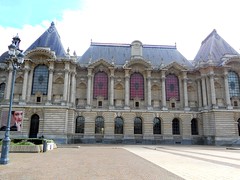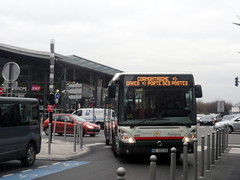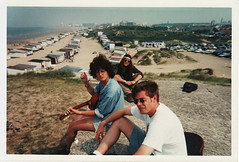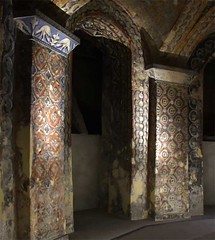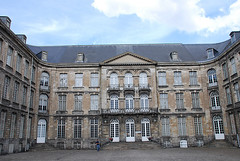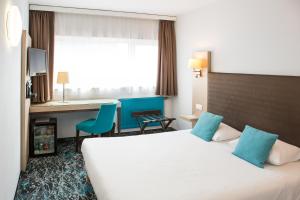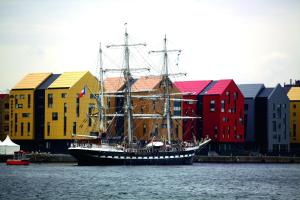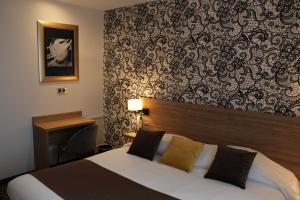Nord-Pas-de-Calais
Nord-Pas-de-Calais (French: [nɔʁ pɑ d(ə) kalɛ]);); is a former administrative region of France. Since 1 January 2016, it has been part of the new region Hauts-de-France. It consisted of the departments of Nord and Pas-de-Calais. Nord-Pas-de-Calais borders the English Channel (west), the North Sea (northwest), Belgium (north and east) and Picardy (south). The majority of the region was once part of the historical (Southern) Netherlands, but gradually became part of France between 1477 and 1678, particularly during the reign of king Louis XIV. The historical French provinces that preceded Nord-Pas-de-Calais are Artois, French Flanders, French Hainaut and (partially) Picardy. These provincial designations are still frequently used by the inhabitants.
With its 330.8 people per km2 on just over 12,414 km2, it is a densely populated region, having some 4.1 million inhabitants, 7% of France's total population, making it the fourth most populous region in the country, 83% of whom live in urban communities. Its administrative centre and largest city is Lille. The second largest city is Calais, which serves as a major continental economic/transportation hub with Dover of Great Britain away; this makes Nord-Pas-de-Calais the closest continental European connection to the island of Great Britain. Other major towns include Valenciennes, Lens, Douai, Béthune, Dunkirk, Maubeuge, Boulogne, Arras, Cambrai and Saint-Omer. The region is featured in numerous films, including Bienvenue chez les Ch'tis.
Name
Nord-Pas-de-Calais combines the names of the constituent departments of Nord (literally 'North', the northernmost department of France) and Pas-de-Calais ('Strait of Calais', the French name of the Strait of Dover). The regional council, however, spells the name Nord-Pas de Calais.
The northern part of the region was historically a part of the County of Flanders, with Douai as its capital. Those who wish to evidence the historical links the region has with Belgium and the Netherlands prefer to call this region the French Low Countries, which also means French Netherlands in French (French: Pays-Bas français; Dutch: Franse Nederlanden or Franse Lage Landen). Other alternative names are Région Flandre(s)-Artois, Hauts-de-France, ('Upper France') and Picardie-du-Nord ('Northern Picardy').
History
Inhabited since prehistoric times, the Nord-Pas-de-Calais region has always been a strategic (and hence one of the most fought-over) region in Europe. French President Charles de Gaulle, who was born in Lille, called the region a "fatal avenue" through which invading armies repeatedly passed. Over the centuries, it was conquered in turn by the Celtic Belgae, the Romans, the Germanic Franks, England, the Spanish and Austrian Netherlands, and the Dutch Republic. After the final French annexation in the early 18th century, much of the region was again occupied by Germany during the First and Second World Wars.
During the 4th and 5th centuries, the Roman practice of co-opting Germanic tribes to provide military and defense services along the route from Boulogne to Cologne created a Germanic–Romance linguistic border in the region that persisted until the 8th century. By the 9th century, most inhabitants north of Lille spoke a dialect of Middle Dutch, while the inhabitants to the south spoke a variety of Romance dialects. This linguistic border is still evident today in the place names of the region. Beginning in the 9th century, the linguistic border began a steady move to north and the east. By the end of the 13th century, the linguistic border had shifted to the river Lys in the south and Cap-Griz-Nez in the west.
During the Middle Ages, the Pas-de-Calais department comprised County of Boulogne and the County of Artois, while the Nord department was mostly made up of the southern portions of the County of Flanders and the County of Hainaut. Boulogne, Artois, and Flanders were fiefs of the French crown, while Hainaut and after 1493 Flanders were within the Holy Roman Empire. Calais was an English possession from 1347 to 1558, when it was recovered by the French throne. In the 15th century, all of the territories, except Calais, were united under the rule of the Dukes of Burgundy, along with other territories in northern France and areas in what is now Belgium, Luxembourg, and the Netherlands. With the death of the Burgundian duke Charles the Bold in 1477, the Boulonnais and Artois were seized by the French crown, while Flanders and Hainaut were inherited by Charles's daughter Marie. Shortly thereafter, in 1492, Artois was ceded back to Marie's son Philip the Handsome, as part of an attempt to keep Philip's father, Emperor Maximilian I, neutral in French King Charles VIII's prospective invasion of Italy.
Thus, most of the territories of what is now Nord-Pas-de-Calais were reunited to the Burgundian inheritance, which had passed through Marie's marriage to the House of Habsburg. These territories formed an integral part of the Seventeen Provinces of the Netherlands as they were defined during the reign of Philip's son, Emperor Charles V, and passed to Charles's son, Philip II of Spain. During the Italian Wars much of the conflict between France and Spain occurred in the region. When the Netherlands revolted against Spanish rule, beginning in 1566, the territories in what is now Nord-Pas-de-Calais were those most loyal to the throne, and proved the base from which the Duke of Parma was able to bring the whole southern part of the Netherlands back under Spanish control. It was also a base for Spanish support of French Catholics in the French Wars of Religion.
During the wars between France and Spain in the 17th century (1635 –1659, 1667–68, 1672–78, 1688–97), these territories became the principal seat of conflict between the two states and French control over the area was gradually established. Beginning with the annexation of Artois in 1659, most of the current Nord department territory had been acquired by the time of the Treaty of Nijmegen in 1678. The current borders were mostly established by the time of the Treaty of Ryswick in 1697.
The area, previously divided among the French provinces of Flanders, Artois, and Picardy, was divided into its two present departments following the French Revolution of 1789. Under Napoleon, the French boundary was extended to include all of Flanders and present-day Belgium until the Congress of Vienna in 1815 restored the original French boundary.
During the 19th century, the region underwent major industrialisation and became one of the leading industrial regions of France, second only to Alsace-Lorraine. Nord-Pas-de-Calais was barely touched by the Franco-Prussian War of 1870; the war actually helped it to cement its leading role in French industry due to the loss of Alsace-Lorraine to Germany. However, it suffered catastrophic damage in the two World Wars of the 20th century.
World War I
When the First World War started, the region became a strategic target for the Allies and the Central Powers, mostly because of the coal and mining resources. When the German troops launched their attack from Belgium, the region was one of the first to fall under German occupation. Nevertheless, when the Allies stopped Germany at the Battle of Marne, the front moved back to the area and stabilized near Arras. During the next four years, the region was split in two: the German holding the French Flanders and Cambrai area, the Allied controlling Arras and the Area of Lens. Nevertheless, the combat did not stop, each side wanting the total control of the area.
The Nord pas de Calais was one of the main theaters of the conflict, with many battles occurring between 1914 and 1918, including the Battle of Vimy Ridge assault during the Battle of Arras (1917), the Battle of Artois, Battle of Loos and the Battle of Cambrai. By the time the region was finally liberated by the Canadian Expeditionary Forces, the entire country was devastated and Arras had been 90% destroyed. Currently, there are 650 military cemeteries throughout the Nord-Pas-de Calais, mostly British and Canadian, as well as large memorials such as the Canadian National Vimy Memorial and Notre Dame de Lorette, the world's largest French military cemetery.
World War II
During the occupation of France, it was attached to the Military Administration in Belgium and Northern France, ruled from the Wehrmacht kommandantur in Brussels. The Nord-Pas-de-Calais region was used for vengeance weapon installations, including extensive V-1 "ski sites" that launched attacks on England and massive bunkers for the V-2 rocket and V-3 cannon. Operation Crossbow counteroffensive bombing by the Allies devastated many of the region's towns. Although most of the region was liberated in September 1944, Dunkirk was the last French town to be freed from German occupation (on 9 May 1945).
Postwar period
| Presidents of Nord-Pas-de-Calais | |||
|---|---|---|---|
| President | Party | Term | |
| Pierre Mauroy | PS | 1974-1981 | |
| Noël Josèphe | PS | 1981-1992 | |
| Marie-Christine Blandin | Green | 1992-1998 | |
| Michel Delebarre | PS | 1998-2001 | |
| Daniel Percheron | PS | 2001- | |
Since the war, the region has suffered from severe economic difficulties (see Economy below) but has benefited from the opening of the Channel Tunnel and the growth in cross-Channel traffic in general.
Demographics
While the region is predominantly French-speaking, it also has two significant minority language communities: the western Flemings, whose presence is evident in the many Dutch place names in the area and who speak West Flemish, a dialect of Dutch (perhaps 20,000 inhabitants of Nord-Pas-de-Calais use Flemish daily and an estimated 40,000 use it occasionally, both primarily in and around the arrondissement of Dunkirk); and the Picards, who speak the Picard language, or Ch'ti (speakers, "chitimi", have been working to revive the nearly-extinct regional speech since the 1980s). Although neighbouring Belgium currently recognizes and fosters both Picard and Dutch, and a few city-level governments within Nord-…
Hotels Nord-Pas-de-Calais
Looking for places related to Nord-Pas-de-Calais?
Those are other destinations to find places related to Nord-Pas-de-Calais:





